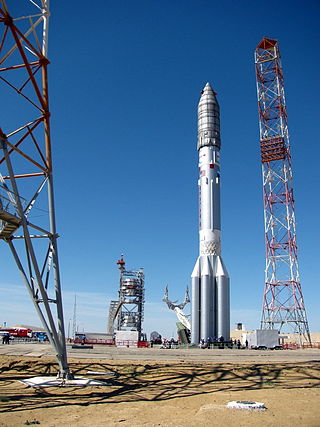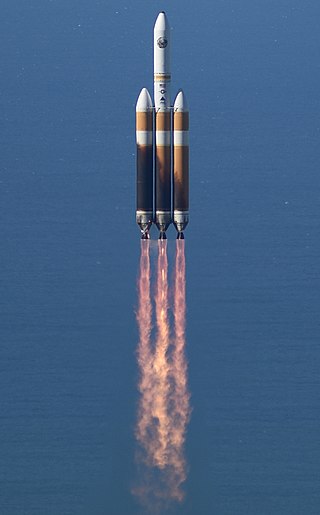
Ariane 5 is a retired European heavy-lift space launch vehicle developed and operated by Arianespace for the European Space Agency (ESA). It was launched from the Centre Spatial Guyanais (CSG) in French Guiana. It was used to deliver payloads into geostationary transfer orbit (GTO), low Earth orbit (LEO) or further into space. The launch vehicle had a streak of 82 consecutive successful launches between 9 April 2003 and 12 December 2017. Since 2014, Ariane 6, a direct successor system, is in development.

The Europa rocket was an early expendable launch system of the European Launcher Development Organisation (ELDO), which was the precursor to the European Space Agency (ESA). It was developed with the aim to delivering space access technology, and more specifically to facilitate the deployment of European-wide telecommunication and meteorological satellites into orbit.

Ariane 1 was the first rocket in the Ariane family of expendable launch systems. It was developed and operated by the European Space Agency (ESA), which had been formed in 1973, the same year that development of the launcher had commenced.

The RL10 is a liquid-fuel cryogenic rocket engine built in the United States by Aerojet Rocketdyne that burns cryogenic liquid hydrogen and liquid oxygen propellants. Modern versions produce up to 110 kN (24,729 lbf) of thrust per engine in vacuum. Three RL10 versions are in production for the Centaur upper stage of the Atlas V and the DCSS of the Delta IV. Three more versions are in development for the Exploration Upper Stage of the Space Launch System and the Centaur V of the Vulcan rocket.

Titan IV was a family of heavy-lift space launch vehicles developed by Martin Marietta and operated by the United States Air Force from 1989 to 2005. Launches were conducted from Cape Canaveral Air Force Station, Florida and Vandenberg Air Force Base, California.

The Scout family of rockets were American launch vehicles designed to place small satellites into orbit around the Earth. The Scout multistage rocket was the first orbital launch vehicle to be entirely composed of solid fuel stages. It was also the only vehicle of that type until the successful launch of the Japanese Lambda 4S in 1970.
Cora was a French experimental rocket. It was the largest rocket ever launched in Western Europe. It was primarily used for testing the second (Coralie) and third stages (Astris) of the multinational Europa Rocket, which was developed and produced by the European Launcher Development Organisation, the predecessor to the present day European Space Agency.

The Soyuz-U launch vehicle was an improved version of the original Soyuz rocket. Soyuz-U was part of the R-7 family of rockets based on the R-7 Semyorka missile. Members of this rocket family were designed by the TsSKB design bureau and constructed at the Progress factory in Samara, Russia. The first Soyuz-U flight took place on 18 May 1973, carrying as its payload Kosmos 559, a Zenit military surveillance satellite. The final flight of a Soyuz-U rocket took place on 22 February 2017, carrying Progress MS-05 to the International Space Station.

The Proton-M, (Протон-М) GRAU index 8K82M or 8K82KM, is an expendable Russian heavy-lift launch vehicle derived from the Soviet-developed Proton. It is built by Khrunichev, and launched from sites 81 and 200 at the Baikonur Cosmodrome in Kazakhstan. Commercial launches are marketed by International Launch Services (ILS), and generally use Site 200/39. The first Proton-M launch occurred on 7 April 2001.

The Atlas I was a US expendable launch system manufactured by General Dynamics in the 1990s to launch a variety of satellites. It was largely a commercial rebrand of the Atlas G, but did feature several electrical and guidance improvements. Atlas I did not feature any major payload capacity improvements over its predecessor but did offer a larger payload fairing option. Eleven launches took place, with three failures.

The Delta IV Heavy is an expendable heavy-lift launch vehicle, the largest type of the Delta IV family. It is the world's third highest-capacity launch vehicle in operation, behind NASA's Space Launch System and SpaceX's Falcon Heavy and closely followed by CASC's Long March 5. It is manufactured by United Launch Alliance (ULA) and was first launched in 2004. ULA will retire the Delta IV Heavy in 2024. As of June 2023, one flight remains.

This comparison of orbital launch systems lists the attributes of all individual rocket configurations designed to reach orbit. A first list contains rockets that are operational or in development as of 2023; a second list includes all upcoming rockets and a third list includes all retired rockets For the simple list of all conventional launcher families, see: Comparison of orbital launchers families. For the list of predominantly solid-fueled orbital launch systems, see: Comparison of solid-fueled orbital launch systems.

A heavy-lift launch vehicle is an orbital launch vehicle capable of generating a large amount of lift to reach its intended orbit. Heavy-lift launch vehicles generally are capable of lifting payloads between 20,000 to 50,000 kg or between 20,000 to 100,000 kilograms into low Earth orbit (LEO). As of 2023, operational heavy-lift launch vehicles include the Long March 5, the Proton-M and the Delta IV Heavy.

The VLM is a proposed three-stage satellite launcher being developed by the Brazilian General Command for Aerospace Technology in collaboration with Germany. The project originated in 2008 as a simplified version of the VLS-1 rocket, using only the core stages. The first launch is currently planned for no earlier than 2023.
Tronador is a series of Argentine rockets, including the Tronador I and Tronador II vehicles, to develop a liquid-propellant rocket expendable launch system called ISCUL.
The Blok DM-03, GRAU index 11S861-03, is a Russian upper stage used as an optional fourth stage on the Proton-M heavy-lift rocket. Three have been launched, the first in December 2010; the first two launches failed before fourth stage ignition, the first as a result of a problem with the Blok DM's fuel load.

The Astris was a liquid rocket engine burning the hypergolic propellant combination of Aerozine 50 and N2O4. A single engine powered Astris third stage of the failed Europa rocket.

A super heavy-lift launch vehicle is a rocket that can lift to low Earth orbit a "super heavy payload", which is defined as more than 50 metric tons (110,000 lb) by the United States and as more than 100 metric tons (220,000 lb) by Russia. It is the most capable launch vehicle classification by mass to orbit, exceeding that of the heavy-lift launch vehicle classification.

A small-lift launch vehicle is a rocket orbital launch vehicle that is capable of lifting 2,000 kg (4,400 lb) or less or under 5,000 kilograms (11,000 lb) of payload into low Earth orbit (LEO). The next larger category consists of medium-lift launch vehicles.

Vanguard SLV-2, also called Vanguard Satellite Launch Vehicle-2 hoped to be the second successful flight of the American Vanguard rocket following successful Vanguard 1 satellite on rocket Vanguard TV-4.
















